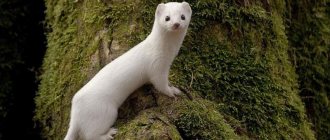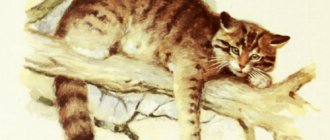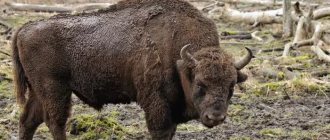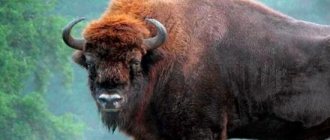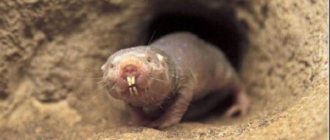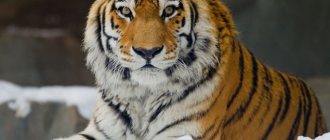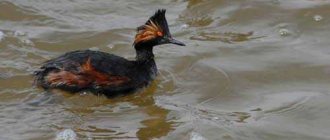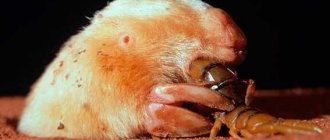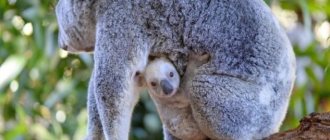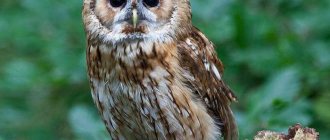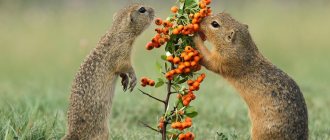The family of these cute, charming, and sometimes cheeky animals is very, very extensive. Due to their omnivorous nature and ability to quickly adapt to almost any climatic conditions, raccoons have been successfully introduced on all continents of our planet and have become many independent subspecies.
So, here are how many species of raccoons there are (main branches):
- Raccoons
- Raccoon-eating raccoons
- Cozumel raccoons
The last species of raccoons is the smallest. These animals live only in Mexico. They have very fluffy fur and a luxurious striped tail. The Cozumel raccoon lives a solitary life ; this animal is not domesticated, although all types of raccoons are capable of living next to humans.
Crayfish inhabit vast areas of South, Central and North America. This species of raccoon received its nickname for its predilection for crustaceans. Crayfish eaters love crabs, lobsters and all kinds of shellfish. Raccoon-eating raccoons are often domesticated. They are used to hunt small rodents and other agricultural pests.
The striped raccoon is the most numerous species of raccoon. The striper can be found in both Americas, and in Europe, and in Asia, and in Africa, and even in Australia. This animal is called the American raccoon, since initially, this predator lived only in North America, from where at the beginning of the 20th century it was artificially introduced into the USSR, and then into many European countries. In Germany, raccoons were bred with the blessing of Goering (an important figure of the Third Reich).
Raccoons are highly domesticated. This subspecies of raccoon is prized for its predilection for eating rodents and reptiles. Gargles are good at clearing the area of poisonous snakes and dangerous reptiles.
This is how many species of raccoons are found in nature.
Position of raccoons in the hierarchy of mammalian predators
Raccoons are a very ancient species of predators. The very first traces of raccoons were found on the territory of modern Europe, from where this animal came to North America, when Eurasia and America were another continent (before the breakup of the lithospheric plates). Those raccoons that remained in Europe were successfully eliminated by wyverns. And the North American family has survived to this day almost unchanged.
Raccoons are a cross between martens and bears. All three species of predators share a common genetic code. Also, olingo, kinkajou and nosuhi are close to raccoons.
Related material: Is it possible to tame a raccoon?
In the past, while studying the species of raccoons, the list of animals with striped colors was replenished with koalas. But, as modern research into the genetic code has shown, koalas are a separate species of animal.
The closest relatives of raccoons are kakimitsli. These animals have a body structure similar to raccoons and a striped tail. Kakomitsli is known as the "half-puma". In part, this animal resembles a cat, only with a long striped tail. Cougars are half nocturnal and are a real threat to small rodents. Many large farms specifically lure this animal closer to their lands so that they destroy the population of small rodents.
Sometimes nature likes to joke and create animals that are very similar to each other. Let's take the raccoon for example. Everyone knows what the animal looks like, at least from our cartoon about a smile. But are you sure that you won’t confuse a raccoon with anyone else? Now we will check it!
Signs about mustachios and stripes
By nature, this is a very sweet and affectionate animal. They are ready to come into contact with children, they are sociable and emotional. Pets are balanced, well-mannered and intelligent in behavior. He can get along well with other pets.
- The Bengal breed is the result of the work of experienced breeders. His ancestor was a wild leopard cat. The modern Bengal differs from other cats in its incredibly beautiful coloring. They are born brindle (classically marbled) or spotted because their genotype contains the T-genes responsible for the tabby color. Marble patterns are less common; these cats are especially prized by lovers of this breed. The main color of the fur of these animals is golden, smoky, white and black.
- One of the main omens associated with the patterns on a cat's body is that an encounter with a tabby cat is about to change. You can learn about the nature of the changes by carefully looking at the frequency and brightness of the stripes and, above all, their color:
Red stripes mean that there is only the appearance of change ahead of you, and all the events associated with them will lead to nothing.
On the other hand, black bars are cause for concern. You may not be going in the best direction.
In addition to the color of the stripes, it is worth paying attention to the color of the tail - if it is white, then it is a good sign, and you can safely make a wish and go to your destination.
Little panda
The red panda lives in forests on the eastern slopes of the Himalayas and the nearby mountains of Western China. The animal is small, with a tail about a meter long, the fur is thick and fluffy, which is why the red panda seems larger than its true size. Her outfit is very colorful.
During the day it sleeps in a hollow or in the fork of a tree; at dusk it awakens, waddling, looking for acorns, roots, lichens and, most importantly, bamboo shoots, juicy and young. With every, even fleeting, alarm, it takes refuge in the trees. And if the path to retreat is cut off, it defends itself desperately, fighting back with paws with sharp semi-retractable claws. The defense methods are similar to those of a bear, but the claws are more likely to be cat-like. Red pandas often live in pairs or families, never in packs. Their cry is loud, some kind of bird screeching.
Apart from two pandas, there are no other raccoons in the Old World. But in America there are 16 species. Raccoons are plantigrade, like bears, some are semi-plantigrade, their claws are semi-retractable or non-retractable. In some ways they resemble small bears, but in some ways they also resemble martens, although in general they are animals of a special family.
Raccoon
The most famous of the raccoons (especially to those who often visit stores selling fur coats) is the striper, or washer, as furriers and Germans call it. They nicknamed him the gargle for his strange habit - to “wash” all his food and various inedible objects in water, when it is nearby.
He rinses, rubs, lowers, and again catches with his front paws everything he wants to eat, so carefully and for a long time that you can’t call it a random whim. But what biological meaning this has is unclear. Some raccoons in captivity even wash their newborn cubs, and so senselessly diligently that they sometimes die after being “washed.”
Character of tabby cats
Animals with this coloration are considered British. They can be called differently and, first of all, it depends on the gender of the kitten. If it is a boy, for example, you can call him Tishka, the girl Rose, or simply Murka. First of all, consider your preferences and wishes.
As already mentioned, the main character trait of such a cat is composure. She is not prone to whims, hysteria and vindictiveness, easily navigates the environment and adapts to almost any conditions. Tabby cats are independent, self-sufficient and self-sufficient.
At the same time, as a rule, they are affectionate and love to become attached to their home and owners, they love to sit quietly in their arms and take a nap in a warm chair. However, you should not treat them like fluffy furniture - they have their own dignity, and they do not like to be offended. In addition, tabby cats are hunters by nature, agile and active when necessary. They just prefer not to waste their energy.
Raccoon dog
Our raccoon dog is exactly like a raccoon dog, and in its habits it resembles its neighbor, the opossum: it is also omnivorous, it also often carries chickens, it jumps and climbs trees just as deftly. Sometimes, like a sloth, he even crawls with his back down along a thin branch, fingering it with his paws. He’s also quite good at playing possum, pretending to be dead when his escape routes are cut off. And just like an opossum or, say, a bear, it sleeps in hollows in winter where the winters are cold. A cheerful, lively, playful, curious and gentle animal. Active at night, sleeps in a tree during the day, and less often in a badger hole. It swims well, and at low tide raccoons travel far beyond the receding sea - they catch crabs and fish in small lagoons and depressions filled with water.
Cubs - two to eight. They will be born in April - early May. Our zoologists have quite successfully acclimatized American raccoons in many places in the country: in the Gomel region, Krasnodar and Stavropol territories, Dagestan, Azerbaijan, Uzbekistan, Kyrgyzstan and Primorsky Territory. However, “in the latter region,” writes G. A. Novikov, “acclimatization is proceeding unsatisfactorily.”
In addition, raccoons that escaped from fur farms have acclimatized in Germany: Hesse, Westphalia and Lower Saxony. On an area of 50 thousand square kilometers, about a thousand raccoons live here in the wild. And about half a thousand more - east of Berlin. Americans brought raccoons to Alaska and the Bahamas. On these and some other islands (Guadeloupe, Barbados, Las Tres Marias), according to American experts, five species of raccoons close to the striper, but special, live. Apparently, these are still only varieties: subspecies or races of the striper. Only the South American crabeater raccoon, although it belongs to the genus of raccoons and has the same habits, is a special species. If you remove the fluffy fur coat from the minnow (and from the tail too) and dress it in thin and short fur, you will get an animal that looks like a crab-eater. That is why the skins of crabeaters are not valued by furriers and are not among the millions of raccoon skins that are sold every year in the fur markets in the United States alone.
Strange and rare animals (61 photos)
In this post there will be scary, nasty, cute, kind, beautiful, incomprehensible animals. Plus a short comment about each. They all really exist. Watch and be surprised.
The slittooth
is a mammal from the order of insectivores, divided into two main species: the Cuban slittooth and the Haitian. The animal is relatively large compared to other types of insectivores: its length is 32 centimeters, its tail is on average 25 cm, the weight of the animal is about 1 kilogram, and its body is dense.
MANED WOLF
.
Lives in South America. The long legs of the wolf are the result of evolution in matters of adaptation to the habitat; they help the animal to overcome obstacles in the form of tall grass growing on the plains. The AFRICAN CIVET
is the only representative of the genus of the same name. These animals live in Africa in open spaces with high grass from Senegal to Somalia, southern Namibia and in the eastern regions of South Africa. The size of the animal can visually increase quite significantly when the civet raises its fur when excited. And her fur is thick and long, especially on the back closer to the tail. The paws, muzzle and tail end are completely black, most of the body is spotted.
MUSHROOM
. The animal is quite famous due to its sonorous name. It's just a good photo.
PROHIDNA
. This miracle of nature usually weighs up to 10 kg, although larger specimens have also been observed. By the way, the length of the echidna’s body reaches 77 cm, and this is not counting their cute five to seven centimeter tail. Any description of this animal is based on comparison with the echidna: the legs of the echidna are higher, the claws are more powerful. Another feature of the echidna’s appearance is the spurs on the hind legs of males and the five-fingered hind limbs and three-fingered forelimbs.
CAPIBARA
. Semi-aquatic mammal, the largest of modern rodents. It is the only representative of the capybara family (Hydrochoeridae). There is a dwarf variety, Hydrochoerus isthmius, which is sometimes considered as a separate species (lesser capybara).
SEA CUCUMBER.
HOLOTHURIA . Sea capsules, sea cucumbers (Holothuroidea), a class of invertebrate animals such as echinoderms. Species eaten as food are commonly known as sea cucumbers.
PANGOLIN
.
This post simply could not do without him. HELL VAMPIRE
. Mollusk. Despite its obvious similarity with octopus and squid, scientists have identified this mollusk as a separate order Vampyromorphida (lat.), because it is characterized by retractable sensitive whip-shaped filaments.
AARDEAKER
.
In Africa, these mammals are called aardvark, which translated into Russian means “earthen pig.” In fact, the aardvark is very similar in appearance to a pig, only with an elongated snout. The structure of the ears of this amazing animal is very similar to that of a hare. There is also a muscular tail, which is very similar to the tail of an animal such as a kangaroo. JAPANESE GIANT SALAMANDER
.
Today it is the largest amphibian, which can reach 160 cm in length, weigh up to 180 kg and can live up to 150 years, although the officially recorded maximum age of the giant salamander is 55 years. BEARDED PIG
. In different sources, the Bearded Pig species is divided into two or three subspecies. These are the curly bearded pig (Sus barbatus oi), which lives on the Malay Peninsula and the island of Sumatra, the Bornean bearded pig (Sus barbatus barbatus) and the Palawan bearded pig, which live, as the name suggests, on the islands of Borneo and Palawan, as well as on Java , Kalimantan and small islands of the Indonesian archipelago in Southeast Asia.
SUMATRAN RHINOS
. They belong to the odd-toed ungulates of the rhinoceros family. This type of rhinoceros is the smallest of the entire family. The body length of an adult Sumatran rhinoceros can reach 200–280 cm, and the height at the withers can vary from 100 to 150 cm. Such rhinoceroses can weigh up to 1000 kg.
SULAWESI BEAR COUSCUS
. An arboreal marsupial living in the upper layer of lowland tropical forests. The fur of the bear cuscus consists of a soft undercoat and coarse guard hairs. Coloration ranges from gray to brown, with a lighter belly and limbs, and varies depending on the geographic subspecies and age of the animal. The prehensile, non-haired tail is approximately half the length of the animal and serves as a fifth limb, making it easier to move through the dense tropical forest. The bear cuscus is the most primitive of all cuscus, retaining primitive tooth growth and structural features of the skull.
GALAGO
. Its large fluffy tail is clearly comparable to that of a squirrel. And his charming face and graceful movements, flexibility and insinuation, clearly reflect his cat-like traits. The amazing jumping ability, mobility, strength and incredible dexterity of this animal clearly show its nature as a funny cat and an elusive squirrel. Of course, there would be a place to use your talents, because a cramped cage is very poorly suited for this. But, if you give this animal a little freedom and sometimes allow him to walk around the apartment, then all his quirks and talents will come true. Many even compare it to a kangaroo.
WOMBAT
. Without a photograph of a wombat, it is generally impossible to talk about strange and rare animals.
AMAZONIAN DOLPHIN
. It is the largest river dolphin. Inia geoffrensis, as scientists call it, reaches 2.5 meters in length and weighs 2 quintals. Light gray juveniles become lighter with age. The Amazon dolphin has a full body, with a thin tail and a narrow muzzle. A round forehead, a slightly curved beak and small eyes are the characteristics of this species of dolphin. The Amazonian dolphin is found in the rivers and lakes of Latin America.
MOONFISH or MOLA-MOLA
. This fish can be more than three meters long and weigh about one and a half tons. The largest specimen of the sunfish was caught in New Hampshire, USA. Its length was five and a half meters, there is no data on weight. The shape of the fish’s body resembles a disk; it was this feature that gave rise to the Latin name. The moon fish has thick skin. It is elastic, and its surface is covered with small bony projections. The larvae of fish of this species and young individuals swim in the usual way. Adult large fish swim on their sides, quietly moving their fins. They seem to lie on the surface of the water, where they are very easy to spot and catch. However, many experts believe that only sick fish swim this way. As an argument, they cite the fact that the stomach of fish caught on the surface is usually empty.
TASMANIAN DEVIL
. Being the largest of modern predatory marsupials, this black animal with white spots on the chest and rump, with a huge mouth and sharp teeth has a dense physique and a stern disposition, for which, in fact, it was called the devil. Emitting ominous screams at night, the massive and clumsy Tasmanian devil looks like a small bear: the front legs are slightly longer than the hind legs, the head is large, and the muzzle is blunt.
LORI
. A characteristic feature of the loris is its large eyes, which can be bordered by dark circles; there is a white dividing stripe between the eyes. The face of a loris can be compared to a clown mask. This most likely explains the animal's name: Loeris means "clown".
GAVIAL
. Of course, one of the representatives of the crocodile order. With age, the gharial's muzzle becomes even narrower and longer. Due to the fact that the gharial feeds on fish, its teeth are long and sharp, located at a slight angle for ease of eating.
OKAPI.
FOREST GIRAFFE . Traveling through Central Africa, journalist and African explorer Henry Morton Stanley (1841-1904) more than once encountered local aborigines. Having once met an expedition equipped with horses, the natives of the Congo told the famous traveler that in their jungle there were wild animals very similar to his horses. The Englishman, who had seen a lot, was somewhat puzzled by this fact. After some negotiations in 1900, the British were finally able to purchase parts of the skin of the mysterious animal from the local population and send them to the Royal Zoological Society in London, where the unknown animal was given the name “Johnston's Horse” (Equus johnstoni), that is, it was assigned to the equine family . But imagine their surprise when a year later they managed to get a whole skin and two skulls of an unknown animal, and discovered that It looked more like a dwarf giraffe from the Ice Age. Only in 1909 was it possible to catch a living specimen of Okapi.
WALABI.
TREE KANGAROO .
The genus of Tree kangaroos - wallabies (Dendrolagus) includes 6 species. Of these, D. Inustus or the bear wallaby, D. Matschiei or Matchisha's wallaby, which has a subspecies D. Goodfellowi (Goodfellow's wallaby), D. Dorianus - the Doria wallaby, live in New Guinea. In Australian Queensland, there are D. Lumholtzi - Lumholtz's wallaby (bungari), D. Bennettianus - Bennett's wallaby, or tharibin. Their original habitat was New Guinea, but now wallabies are also found in Australia. Tree kangaroos live in tropical forests of mountainous regions, at altitudes from 450 to 3000m. above sea level. The body size of the animal is 52-81 cm, the tail is from 42 to 93 cm long. Wallabies weigh, depending on the species, from 7.7 to 10 kg for males and from 6.7 to 8.9 kg. females. WOLVERINE
. Moves quickly and deftly. The animal has an elongated muzzle, a large head, with rounded ears. The jaws are powerful, the teeth are sharp. Wolverine is a “big-footed” animal; its feet are disproportionate to the body, but their size allows them to move freely through deep snow cover. Each paw has huge and curved claws. Wolverine is an excellent tree climber and has keen eyesight. The voice is like a fox.
FOSSA
. The island of Madagascar has preserved animals that are not found not only in Africa itself, but also in the rest of the world. One of the rarest animals is the Fossa - the only representative of the genus Cryptoprocta and the largest predatory mammal living on the island of Madagascar. The appearance of the Fossa is a little unusual: it is a cross between a civet and a small puma. Sometimes the fossa is also called the Madagascar lion, since the ancestors of this animal were much larger and reached the size of a lion. Fossa has a squat, massive and slightly elongated body, the length of which can reach up to 80 cm (on average it is 65-70 cm). The fossa's paws are long, but quite thick, with the hind paws being higher than the front paws. The tail is often equal to the length of the body and reaches up to 65 cm.
MANUL
approves of this post and is here only because he must be present. Everyone already knows him.
PHENEC.
STEPPE FOX . He assents to the manula and is present here insofar as. After all, everyone saw him.
THE NAKED NARROW
gives the Pallas's cat and the fennec cat a plus in their karma and invites them to organize a club of the most fearful animals on the RuNet.
PALM THIEF
. Representative of decapod crustaceans. Its habitat is the western Pacific Ocean and the tropical islands of the Indian Ocean. This animal from the family of land crayfish is quite large for its species. The body of an adult reaches a size of up to 32 cm and a weight of up to 3-4 kg. For a long time it was mistakenly believed that with its claws it could even crack coconuts, which it then eats. To date, scientists have proven that crayfish can only feed on already split coconuts. They, being its main source of nutrition, gave the name palm thief. Although he is not averse to eating other types of food - the fruits of Pandanus plants, organic substances from the soil, and even his own kind.
The name of this fish in Latin sounds too boring, so it’s easier to call it
FISH WITH A TRANSPARENT HEAD
. She has a transparent head through which she can see with her tubular eyes. The head, through which the fish watches for prey, helps protect the eyes. First opened in 1939. It lives at a much greater depth, so it has not been fully studied. In particular, the principle of fish vision was not entirely clear. She was supposed to have great difficulty due to the fact that she could only look up. Only in 2009 was the structure of the eye of this fish fully studied. Apparently, when trying to study it earlier, the fish simply could not tolerate the change in pressure.
ECHIDNA
.
Well, that's all. LESS RED PANDA
.
Today, the red panda in its natural habitat can only be found in the mountain bamboo forests of the Chinese provinces of Yunnan and Sichuan, in northern Burma, Bhutan, Nepal and northeast India. SIFAKA
. Monkey of the Indriidae family. A relatively new genus of primates, discovered only in 2004. Silky sifakas live in the eastern part of the island of Madagascar. The area is approximately 2.2 thousand square meters. km. The distribution area is limited in the north of the island to the Marojejy Massif region, and in the south it reaches Anjanahari. Adult individuals have a body length with a head from 45 to 55 cm, a tail 45-51 cm long. Weight is 5-6.5 kg.
SLOTH
. A very interesting species of mammals, possessing a number of distinctive features that make it unlike any other existing species. It lives mainly in Central and South America.
platypus
. In principle, everyone knows it. But this photo deserves attention...
ANTEATER
. It won't surprise anyone either. But the shot is great...
tarsier
. A small mammal from the order of primates, the very specific appearance of which created a somewhat ominous aura around this small animal weighing up to one hundred and sixty grams. Thus, the indigenous population of Indonesia and the Philippine Islands associated the absurd appearance of the tarsier with the tricks of evil spirits. However, many of our contemporaries, who see the tarsier for the first time in its native habitat, remain amazed by its non-standard appearance.
MARGAY
. These wild cats are distinguished from their “relatives” by their body size and proportions, as well as their lifestyle. For example, the margay is very similar to its closest relative, the ocelot, which, moreover, is quite often found in the same place where the margay lives. It is not difficult to distinguish these cats - the ocelot is noticeably larger, since it prefers to hunt on the ground, and the margay has longer legs and tail, due to life mainly in trees.
MUD JUMPER
. Found in intertidal areas and in areas such as tropical swamps formed by mangrove trees. Mudskippers especially love to settle in places where fresh water meets sea water. And although from a scientific point of view they are fish, many perceive them as amphibians. Well, in a way it is.
HERBIVORE DRACULA
. Bats (“Sphaeronycteris toxophyllum” lat.) This species lives in the north of South America (Amazon River basin and mountains). These bats, oddly enough, are herbivores.
BELT-TAIL
. The habitat of belted tails extends to the rocky regions of Africa, which have an arid climate, mainly on the southern side of the Sahara Desert. In addition, belted tails live in certain numbers on the island of Madagascar. There are more than forty species of belttails in the world. The sizes of belt-tails vary quite widely and range from 12 to 70 centimeters in length. The entire body of the belt-tail is covered with rectangular plates - scales, which cover the bony base of the reptile.
In my opinion, a modest fellow.
LILE FROG
. Some animals have managed to adapt to these, at first glance, very difficult conditions and have even learned to benefit from the changing seasons. So the indigenous Indian purple frog (Nasikabatrachus sahyadrensis), which as a species was discovered quite recently - in 2003, uses the monsoon time to its advantage - to continue its kind.
ISOPOD
.
Giant isopod woodlice, approximately 30 cm long, live at sea depths of about 1.6 km. SUN BEAR
. The Malayan biruang bear, or, as it is also called due to its characteristic color, the sun or honey bear, lives in India, Myanmar, as well as on the islands of Borneo, Java and Sumatra. It is of quite great interest to both zoologists and wildlife lovers, since this species is one of the smallest, most aggressive and smallest representatives of the entire bear family. By the way, it was precisely the threatening small number of this genus that became the reason for the inclusion of biruangs in the Red Book. An adult sun bear has a very difficult character. However, quite a lot of interest in his person is caused not at all by his habitat, and not by his character, but by his stunning appearance, which immediately catches the eye from any photograph.
TIBETAN FOX
. Found in Tibet, northwest India and northern Nepal at high altitudes.
MEDUSA
. Just a giant jellyfish.
GOLDEN TIGER
.
This is what tigers with a similar color are called. The reason for the unusual color is that one of the genes did not work. Count like an albino... AY-AY.
ARM POD . Madagascar monkey or aye-aye, a mammal of the suborder of prosimians; the only representative of the family of arms. Body length 40 cm, tail 60 cm. The head is large, the muzzle is short; The ears are large and leathery. The tail is fluffy. The coat color ranges from dark brown to black.
GUYDAK
. A large gastropod weighing up to one and a half kilograms. Found off the west coast of the USA. From under the thin fragile shell of the guidac (about 20 cm in length) protrudes a “leg” that is three times larger than the shell. The English name for this mollusk (geoduck, gweduck) appeared at the end of the 19th century, is derived from the name of these mollusks in the language of the Nisqual Indians (which is why it is pronounced “guiduck”) and means “deep-digging” - these mollusks really bury themselves quite deeply in the sand.
MARSPALY WOLF
.
It is an extinct marsupial mammal and the only representative of the thylacine family. This animal is also known as the “marsupial tiger” and “Tasmanian wolf”. At the beginning of the Holocene and the end of the Pleistocene, the marsupial wolf was found on the Australian mainland and the island of New Guinea. About 3,000 years ago, Aboriginal settlers brought the wild dog dingo to the island, as a result of which the marsupial wolf disappeared from the area. In the XVIII-XIX centuries. Tasmania was considered the main habitat of the marsupial wolf, but in the thirties of the 19th century, mass extermination of the animal began, which was mistakenly considered a destroyer of domestic sheep. In addition, the thylacine was credited with hunting poultry and exterminating game caught in traps. Most of these legends turned out to be untrue. LAMPRIPE
.
A species under threat of extinction. Reaches a length of 120 cm and a weight of 3 kg. Spawns in June-early July in rivers. The male builds a nest with a diameter of about 50 cm and guards it. After spawning, the spawners die. The larvae live in the river for 5-6 years, after metamorphosis, the young lampreys slide into the sea, the sea period is about 3 years. In the sea they attach themselves to fish (external parasites of large fish) - cod, flounder, etc. Starfish . An insectivorous mammal of the mole family. Externally, the starfish differs from other members of the family and from other small animals only in its characteristic stigma structure in the form of a rosette or star of 22 soft, fleshy, mobile bare rays. In size, spade-shaped forelimbs, thick velvety fur (black or dark brown) it is similar to the European mole.
Kakomitsli
There are no crabeater raccoons in North America, but there lives here, in the southern states, another very cute animal of the same breed - kakimitsli, “cat squirrel”, or baby raccoon. It is slightly larger in size than a squirrel: its fluffy tail is 37 centimeters long, everything else is about the same. Yellowish-gray, the ears are large, and the tail is completely, from root to tip, in black and white rings. A very impressive tail.
A forest animal, it climbs trees no worse than a squirrel, but also lives in rocky deserts, in bushes and on hills. Shy, cautious and only hunts for prey at night; therefore, even where there are many “cat squirrels”, people rarely see them. The larger gray camomitsli lives in Central America.
In addition to stripers, crabeaters and camomitsli, the raccoon family includes three more species of noses, or coatis, kinkajous and three species of olingos (some live in South and Central America, and one species of noses lives only on the island of Cozumel, east of Yucatan) .
coati
Coatis are brave, playful and very active animals. Their whole day is spent worrying about food. In small groups of about a dozen females and cubs, with their tails raised high, they dig the ground with long muzzles with very mobile noses. They smell a worm or larva in an old stump, sniffle, purr, and scratch with their claws. The entire forest is carefully combed - some down on the ground, others up in the trees. And everything is suitable for them as food: lizards, birds, insects, shellfish, roots, various fruits. As soon as they notice something suspicious, they immediately whistle loudly - and instantly the whole flock is already in the trees. It is safer to find out the causes of anxiety from above. At night they also sleep in trees, stretched out on thick branches. All other raccoons, on the contrary, roam at night.
They swim well and love water. There are small membranes between the fingers of the nose. Their habit, like that of a raccoon, is to rinse their paws, various objects, and even their tail in water! (They say about tame coatis that they cannot stand smokers. As soon as the owner lights a cigarette, he tries to snatch the cigarette from him and throw it away!)
Striped cat
The material in this article contains up-to-date information about these cats, as well as answers to frequently asked questions, which makes it possible to get to know them better and get a general idea about these four-legged pets.
Tabby cat, what breed and its name, price, brief description and character
Not everyone knows that tabby cats are not a breed. The peculiar coat color is called “striped”. The main difference between these cats is a mark on the forehead that resembles the letter M.
It is believed that such representatives of cats are more resistant to disease, and they probably have the best health. Numerous studies have shown that the gene responsible for the formation of stripes is directly related to immunity. It is no coincidence that such cats are long-lived.
The character is flexible and playful. An animal never offends its owner. The cost varies from two to six thousand.
Striped cat breeds rating
Tabby cats are the most popular in our country; they are loved and ready to take care of them. The most popular of them:
The Asian golden cat has a predatory appearance, powerful body and legs. Pixie BOB is a small kitten with fringed ears and a short tail. The animal is especially suitable for lovers of something unusual and bright.
The Briton - despite the fourth place, people like him the most. A charming animal, kind and affectionate.
Tabby kitten with big ears breed
In fact, there are a lot of breeds of tabby cats, and it is simply impossible to list them all.
Tabby kitten with round spots, what breed
Scottish Folds are of the Scottish type, but, unlike other breeds, they have fold ears. This is a unique breed, the cats are affectionate and love to play. But their main distinguishing feature is their ears.
Tabby cat with white chest and paws
This breed is called Bengal. Kittens are very active and active, spending a lot of time moving around. Many owners don’t like the fact that they are conquerors of the top things - curtains, cabinets, etc. But there’s no escape, and if you decide to have such a pet, you’ll have to adopt its habits.
Gray tabby kittens what to call
The Cymric is a breed developed in Great Britain. The animals are small in size and strongly attached to humans. However, their behavior shows traits that are more characteristic of dogs than cats - they like to bury toys and swim in water. Training such a cat will not be difficult.
Kinkajou
The kinkajou is a small animal, gray-red, with a long, prehensile tail. The tail is its most remarkable feature. Only the binturong, a South Asian animal from the civet family, has a tail so capable of firmly grasping branches. None of the predators have any more.
The kinkajou is very similar to the olingo, but is distinguished by its prehensile tail. Kinkajou and the South Asian binturong from the civet family are the only predatory animals endowed with a tail capable of grasping branches.
The kinkajou's tongue is also notable, it is long and thin. That tongue can squeeze into any gap and extract as much honey as the animal wants. Honey and fruits are his delicacy. But the prehensile-tailed raccoon also destroys bird nests and, on occasion, eats various small animals. Kinkajou is good-natured and playful. It gets used to people quickly; tame kinkajous often live in Indian villages. The second name of this animal is potto. This is also the name of a lemur in Africa, potto, which is a strange thing! - looks a little like a kinkajou, although it is not at all related to it.
